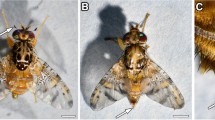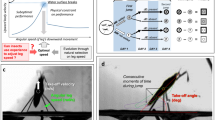An innovative leaping action propels these bugs to the top of the insect athletic league.
Abstract
There are two basic body designs for jumping that enable many animals to escape from predators, to increase their speed of locomotion or to launch into flight1. Animals with long legs (bush babies, kangaroos and frogs, for example) have a levering power that enables them to use less force to jump the same distance as short-legged animals of comparable mass, whereas those with short legs must rely on the release of stored energy in a rapid catapult action. Insects exploit both designs: bush crickets use the leverage provided by long legs2, fleas use stored energy to power their short legs3, and grasshoppers4 combine features of each. Fleas are considered to be the champion jumpers, but here I show that froghoppers (spittle bugs) are in fact the real champions and that they achieve their supremacy by using a novel catapult mechanism for jumping.
Similar content being viewed by others
Main
Froghoppers, Philaenus spumarius (Linnaeus), have a mass (m) of 12.3 ± 0.7 mg (mean ± s.e.m., n = 11) and are 6.1 ± 0.2 mm long. In preparing to jump (in ten jumps by four adults), the front and middle legs raise the front of the body and the thrust is then provided by the simultaneous extension of both hind legs in less than 1 ms (Fig. 1). These lift the body at a take-off angle of 58 ± 2.6° and the mean take-off velocity (v) is 2.8 ± 0.1 m s−1 (or, for the best jumps, 4 m s−1). The body is thus accelerated at 2,800–4,000 m s−2, which is equivalent in the best jumps to 408g.
The energy (0.5mv2) required for an average jump is 49 microjoules, with the best jumps needing 100 µJ. This corresponds to an average power output of 100 mW if the acceleration (f) is conservatively applied in 1 ms. About 11% (n = 5) of the body weight is attributable to the pair of trochanteral depressor muscles in the body that generate the rapid movements of the hind legs, giving a power output of 36 W g−1 and a maximum for the best jumps of 74 W g−1.
This is much greater than the power output from the jumping muscles in a locust and about the same as that in a flea, but less than that in a click beetle5,6. The force (mf) exerted in an average jump is 34 mN. For the highest jumps, the force increases to 49 mN and, because the cross-sectional area of this muscle is 1.2 mm2, it equates to 41 kN m−2 of muscle7. The average height achieved is 428 ± 26.1 mm, with the highest jumps reaching 700 mm.
The forces powering the jump could not be produced by direct muscle contractions over the short distances and brief time available, indicating that muscular force must be generated by a slow contraction in advance of the movement, storing energy which is then released rapidly. The hind legs are roughly half the length of the body and 1.5 times that of the other legs. Before take-off, they are rotated forwards at the coxo-trochanteral joints so that the femora are tucked between the thorax and the middle legs. The tibiae are also flexed about the femora so that they are parallel with the long axis of the body. A ridge on the dorsal femur rides over and engages in front of a lateral and ventral protrusion of a coxa, forming a novel locking mechanism and restraining a hind leg so that it is poised to extend (see supplementary information). A hind leg does not move in this cocked position, so the energy generated by an almost isometric contraction of the trochanteral depressor muscle could be stored in the strengthened thoracic cuticle, which may contain resilin8,9, or in its massive and elaborate tendon.
For a hind leg to extend, the femur must disengage with the coxa, probably because the force generated by the trochanteral depressor muscle exceeds the restraining ability of the lock. The femoral ridge then suddenly snaps past the coxal protrusion, allowing the stored force to power a rapid depression of the coxo-trochanteral joint at angular velocities of 75,500 deg s−1 and a concomitant full extension of the femoro-tibial joint. The time taken from the first visible leg movements to the insect becoming airborne is no more than 1 ms.
For their size, froghoppers outperform other insects: they exceed the height jumped by the flea relative to body length and accelerate their much heavier bodies four times faster. The force exerted is 414 times their body weight and is therefore much higher than in other jumpers such as fleas (135 times)3, locusts (8 times)4 and humans (2–3 times)10. Froghoppers have relatively short and light hind legs that are powered by huge jumping muscles and a novel locking mechanism that allows force generated before the jump to be released rapidly. During horizontal walking, this specialization is such that the hind legs are merely dragged along while they are poised for jumping.
References
Alexander, R. M. Phil. Trans. R. Soc. Lond. B 347, 235–248 (1995).
Burrows, M. & Morris, O. J. Exp. Biol. 206, 1035–1049 (2003).
Bennet-Clark, H. C. & Lucey, E. C. A. J. Exp. Biol. 47, 59–76 (1967).
Bennet-Clark, H. C. J. Exp. Biol. 63, 53–83 (1975).
Evans, M. E. G. J. Zool. Lond. 169, 181–194 (1973).
Bennet-Clark, H. C. in Perspectives in Experimental Biology (ed. Spencer Davies, P.) 467–479 (Pergamon, Oxford, 1976).
Weis-Fogh, T. J. Exp. Biol. 33, 668–684 (1956).
Sander, K. Zool. Jb. Jena (Anat.) 75, 383–388 (1957).
Rothschild, M., Schlein, J., Parker, K., Neville, C. & Sternberg, S. Phil. Trans. R. Soc. Lond. B 271, 499–515 (1975).
Dowling, J. J. & Vamos, L. J. Appl. Biomechan. 9, 95–110 (1993).
Author information
Authors and Affiliations
Ethics declarations
Competing interests
The author declares no competing financial interests.
Supplementary information
Rights and permissions
About this article
Cite this article
Burrows, M. Froghopper insects leap to new heights. Nature 424, 509 (2003). https://doi.org/10.1038/424509a
Issue Date:
DOI: https://doi.org/10.1038/424509a
This article is cited by
-
Control of high-speed jumps: the rotation and energetics of the locust (Schistocerca gregaria)
Journal of Comparative Physiology B (2023)
-
First report of Mesoptyelus nigrifrons on the dove tree (Davidia involucrata Baill.) in China
Journal of Plant Diseases and Protection (2023)
-
Jumping robot bests biology by enhancing stored energy
Nature (2022)
-
The physiological, structural, and behavioral adaptations of the “fore-mid” four-legged walking of the pygmy mole cricket Xya sichuanensis (Orthoptera: Tridactylidae)
Applied Entomology and Zoology (2022)
-
The Unique Strategies of Flight Initiation Adopted by Butterflies on Vertical Surfaces
Journal of Bionic Engineering (2021)
Comments
By submitting a comment you agree to abide by our Terms and Community Guidelines. If you find something abusive or that does not comply with our terms or guidelines please flag it as inappropriate.




